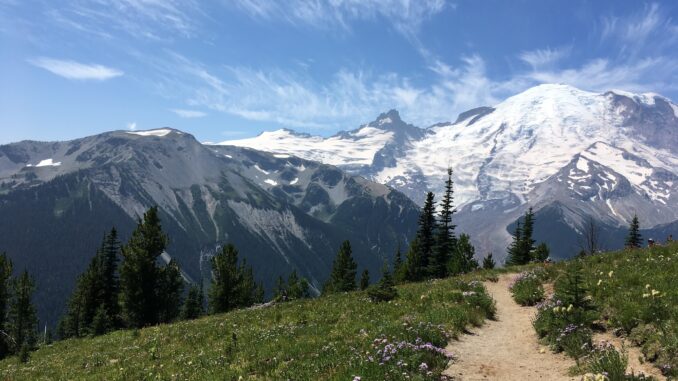
Despite our current pandemic and the necessity for caution in public spaces, the Hudson Valley’s fall foliage seems to lure quarantined homebodies outdoors. Weekend northbound traffic appears like a dystopian thriller’s escape from a New York City zombie apocalypse.
As if this longtime freedom to leave home were some newfound inalienable right, leaf peepers, albeit fashionably, traverse the wooded terrain in Minnewaska State Park and the Mohonk Preserve only to document their day on Instagram.
Of course, the post features prolific Patagonia branded vests, synchillas, hats and breathable windbreakers. It is made complete with a cliché caption about the Lemon Squeeze, ready to be instantaneously uploaded to Instagram and mindlessly double-tapped.
But what if I told you those fashionable vests and synchillas help fund an underlying initiative and one that works to make trekking and traversing trailheads a timeless endeavor? Patagonia is a Certified B Corporation, making it a for-profit company that meets rigorous social and environmental performance standards of accountability and transparency. In 2018, the environmentally-conscious corporation announced that it would donate the $10 million it received from President Trump’s tax cuts to groups committed to protecting air, land and water and finding solutions to the climate crisis. Further, the Ventura, California based company commits 1% of its total sales to environmental groups through One Percent for the Planet, a non-profit environmental organization – co-founded by the man who started Patagonia, Yvon Chouinard. Yes, its retail prices may be egregious, but the money is spent appropriately in turn.
But this is not a column on brand awareness, but rather one about environmental awareness.
This fall, while hikers, social media influencers and other sharply contrasting cultural personas explored the great outdoors in unison (and concerning pandemic protocols), Patagonia happened to release a feature-length documentary, “Public Trust,” about America’s system of public lands and the fight to protect them. Public lands are lands owned and directly managed by the federal government and used for public purposes — the wild places where we camp, hike, run, ride, hunt, climb and swim; this is not to be confused with private lands or lands owned by individuals and corporations.
As the film explains, all United States lands, public and private, are the Indigenous people and Tribal nations’ ancestral lands. Today, there are 614 million acres (26.6% of the U.S.) that are held in trust for the public and managed by the federal government – Bureau of Land Management, the U.S. Forest Service, the U.S. Fish and Wildlife Service, the Department of Interior and the National Park Service. Despite bipartisan support from voters across the political spectrum, the American public lands face unprecedented threats from extractive, capitalistic industries and the politicians they puppeteer. Patagonia’s film “Public Trust” is a marvelous political exposé that underscores the importance of the democratic process and the accountability placed on elected officials.
The film awakens its audience to a current governmental movement, albeit anti-conservation, wherein the Trump administration is systematically remaking U.S. policies toward public lands. It is moving virulently to open previously protected areas for development — the film documents the sheer evil across the United States by way of the Boundary Waters of Minnesota, to the red rocks of Utah, to the nation’s largest national forest in Alaska.
According to a study in the journal Science, our current president, who hides behind a tawny mascara, and who just last month lost a reelection bid, is, unsurprisingly, responsible for the most massive reduction of protected public lands in our nation’s history. Most reductions result from the exchange of public land leased to oil and gas corporations, mining operations and logging companies, especially across the Western states, where these tracts of federal land offer robust pecuniary opportunities.
This administration is the only one in U.S. history to have removed more public lands than it has protected. This capitalistic practice threatens the plant and animal life that call these lands home, and Indigenous peoples and their respective cultures and customs.
I write in the hope that you, the reader, begins to recognize the “war on public lands,” if you haven’t already. Many of Trump’s campaign positions like energy independence and opposition to climate change regulations like the Clean Power Plan — a policy signed into action during former President Barack Obama’s presidency aimed at combating global warming — and the Paris Agreement — an agreement within the United Nations Framework Convention on Climate Change, addressing greenhouse-gas-emissions mitigation, adaptation, and finance — have worsened United States environmental behaviors.
It is our job to keep our recently elected administration accountable to its promises to fight global warming. The deal makes a historic investment in clean energy and climate research and innovation. It incentivizes the rapid deployment of clean energy innovations across the economy, especially in communities most impacted by climate change. If successful, President-elect Joe Biden and Vice President-elect Kamala Harris ensure the US will achieve a 100% clean energy economy and reach net-zero emissions no later than 2050. A successful Green New Deal devalues oil and gas operations as it does mining and logging too — a boon to our public lands. That means that over the next four years, our newly appointed administration should not reduce more public land, and in turn should work to return it to the larger size that pre-existed Trump.
After all, our nation needs more green to replace all that orange.
